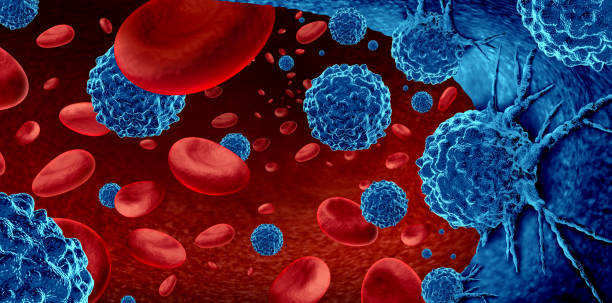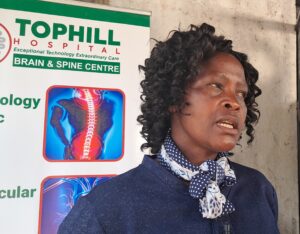What You Did Not Know About Myeloma Disease

Cancer in the blood outbreak and treatment for malignant cells in a human body caused by carcinogens and genetics with a cancerous cell as an immunotherapy and leukemia or lymphoma symbol and medical therapy as a 3D render.
The international community has set aside the month of March to create awareness around multiple myeloma.
Though referred to as a silent cancer, multiple myeloma accounts for 10% of all blood cancers, the second most type of blood cancer.
Multiple myeloma is a type of bone marrow cancer. Bone marrow is the spongy tissue at the center of some bones that produces the body’s blood cells. It’s called multiple myeloma as the cancer often affects several areas of the body, such as the spine, skull, pelvis and ribs. This is according to the description by United Kingdom National Health Services (NHS).
Dr Beatrice Meli, a hematologist with the Moi Teaching and Referral Hospital says Multiple myeloma cases have grown over the years in Kenya but the level of awareness among members of the public remains low.
“Myeloma is not your common type of cancer but the statistics are a worrying concern for professionals since the level of awareness remains low. This type of blood cancer is caused by excessive production of plasma cells in the bone marrow where blood cells are produced in plenty and then interferes with the production of blood,” said Meli.
According to Dr Meli, there are many blood cancers but Multiple Myeloma is one of the major blood cancers around the globe but only accounts for 1% of cancers globally as compared to the other cancer diseases.
“Compared to other types of blood cancer like Leukemia and Lymphoma, multiple myeloma is the commonest in Uasin Gishu and the second commonest in Kenya after Lymphoma making it a silent blood cancer disease.” She added.
On why it’s not easy to detect myeloma, Doctor Meli says the symptoms may pass as normal unless an individual has a higher level of suspicion index or has prior information about multiple myeloma.
“The implication of this disease is huge. First, for the process of diagnosis of multiple myeloma mostly it takes time before the medical practitioner thinks that the patient has this kind of blood cancer. We call it a low index of suspicion. For you to think of Multiple myeloma you need to have a high index of suspicion. This disease does not have a sign that shows its presence. By the time the patient is diagnosed he or she will be coming in with maybe kidney failure, low blood, broken bones.” Dr Meli explained.
There being no cure for multiple myeloma, the diagnosis comes with a lot of costs and takes time to control the disease, severely impacting the patients family who will be required to spend a lot on the tests to control the disease that has no cure at the moment.
“There are many tests that will be run during the diagnosis including bone marrow test and other tests which takes a lot of time and there will be an increase in cost of up to sh 50,000 before the diagnosis process is completed. The process of treating it is more challenging. It takes months to be able to control it and even you need to be followed for a lifetime because there is no cure for Multiple myeloma but it is a disease that can be controlled.” She added.
Dr Meli says introduction of novel therapy a few years ago has been of benefit to the patients which are still being adopted across hospitals in the country.
“A lot has changed. There are novel therapies that have come up in the last 10-15 years and that are what we are trying to tap in to make sure the impact on the patient is not much. There is impact along all those levels, the process towards diagnosis, the diagnosis and treatment,” she said.
The disease varies from person to person depending on the race and age. A study conducted in the USA revealed that Caucasians and black people are more likely to suffer from multiple myeloma than whites while older generations and males are likely to suffer from the disease more than the younger generations and females respectively.
Risk factors for developing multiple myeloma cancer can be classified as modifiable and non-modifiable factors.
Modifiable factors are the ones that you as an individual can prevent from having while non modifiable are those you can’t control like age. Multiple myeloma is common in the older population and Dr Meli says a study conducted within a period of ten years revealed most victims in the country and at AMPATH average 61 years. However the doctor says they have a patient aged 26 years at the MTRH.
Ebby Tanui is a caregiver at AMPATH MTRH and states the need to have psychological and mental wellness talks with the patients, till they reach a level where they can handle other information. Tanui has helped her cousin walk through myeloma treatment and she has some advice for members of the public.
“The primary care should be psychological, mental wellness. You talk to the patient till they reach where they treat this as a condition that can be managed. Once it settles in their mind, it becomes easier to handle the other things that come along with that because the word multiple myeloma might be a strange word to most people until you let them know it’s a type of cancer,” said Tanui.
The country however continues to confront the problem of personnel as there are only 20 hematologists in the country against a population of over 50 million Kenyans. Dr Meli opines that there is a need to educate members of the public on multiple myeloma and raise the level of awareness other than building capacity for referral facilities to screen and detect the condition earlier.






